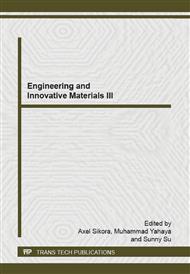p.3
p.7
p.12
p.17
p.22
p.27
p.31
p.36
The Influence of Carbon Addition on Microstructure and Mechanical Properties of Fe-22.0Al-5.0Ti Alloy
Abstract:
The effect of carbon addition on Fe-22.0Al-5.0Ti alloy on structure and properties has been investigated. Microstructural and phase analysis have been investigated by using optical microscopy, scanning electron microscope (SEM) equipped with EDAX. For low carbon addition (0.1 wt.%), two-phase microstructure consisting of precipitates of TiC in B2 matrix. The presence of large amount of carbon (1.0 or 1.5 wt.%) resulted formation of Fe3AlC0.5 and TiC precipitates in B2 matrix. The results show that the mechanical properties of Fe-22.0Al-5.0Ti increased with increase in the carbon content and strongly depend upon nature and volume fraction of different precipitates. The volume fraction of precipitates increased with increase in the content of carbon. The behavior of Fe-22.0Al-5.0Ti alloy was explained by the combined effect of precipitation hardening and solid solution strengthening. The main effect of addition of carbon related to improvement in the compressive strength without loss in the ductility. The decrease in the wear rate is mainly attributed to the high hardness of the composites and as well hard TiC play a role of load carrying.
Info:
Periodical:
Pages:
17-21
Citation:
Online since:
October 2014
Authors:
Keywords:
Price:
Сopyright:
© 2014 Trans Tech Publications Ltd. All Rights Reserved
Share:
Citation:


